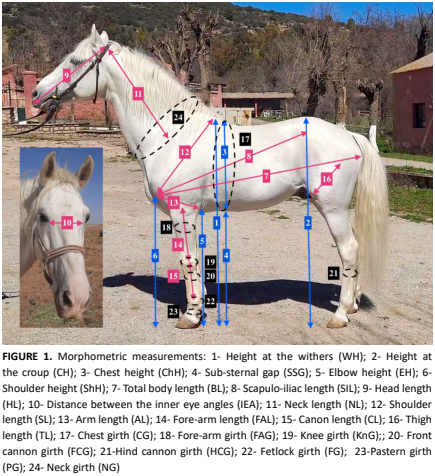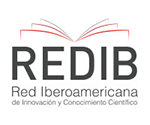Características morfométricas del caballo Barbado en Argelia y factores de variación asociados
Resumen
El objetivo de este investigación era contribuir a la caracterización morfométrica del caballo Barb de Argelia, estudiar sus variables dimensionales, explorar sus características específicas y su diversidad, y evaluar sus determinados factores de variación. Un total de 52 caballos Barb registrados en el Studbook argelino y con una edad de 3 años o más, estaban objeto de una evaluación basada en 24 parámetros corporales. El estudio estadistico se realizó conforme a un modelo lineal general para evaluar la variación de las variables morfométricas en función de la edad, el sexo, el perfil cefálico y el color de la capa. Además, se realizó un análisis de componentes principales. Los resultados se clasificaron en variables de altura, longitud, perímetro, peso e índices corporales. La altura media a la cruz y la altura de la grupa estaban de 150,8 ± 3,38 cm y 150,7 ± 3,50 cm, respectivamente, con una longitud corporal media de 150,0 ± 4,73 cm. Estos valores casi iguales indicaron un índice corporal de perfil de 1,01 ± 0,02, lo que revela una conformación de proporciones cuadradas. El perímetro torácico medio y la circunferencia del hueso del cañón estaban de 177,8 ± 8,73 cm y 19,63 ± 0,95 cm, respectivamente, lo que condujo a un índice dáctilotorácico de 1,18 ± 0,05, demostrando una robustez esquelética coherente con un peso corporal estimado de 441,61 ± 50,85 kg. El análisis de la variación de las medidas reveló algunas diferencias significativas (p < 0,05), en particular para la distancia subesternal, la altura del hombro, la longitud del hombro, la longitud del brazo, la distancia entre los ángulos internos de los ojos, y las circunferencias del hueso del cañón (circunferencia del hueso del cañón y HCG). En conclusión, todos los parámetros medidos estaban en conformidad con el estándar racial. Sin embargo, la comparación con estudios similares revela disparidades notables, lo que indica una amplia gama de expresiones morfológicas dentro de la población clasificada como caballos Barb.
Descargas
Citas
Rahal K, Guedioura A, Oumouna M. Paramètres morphométriques du cheval barbe de Chaouchaoua, Algérie. Rev. Med. Vet. [Internet]. 2009 [cited May 25 2025]; 160(12):586–589. Available in: https://goo.su/87iLMY
Kadri A. Le cheval barbe, cheval du Nord de l’Afrique, son rôle en Algérie. Rev. OMCB [Internet]. 2006; 2006(1):9– 45.
FAO. Domestic Animal Diversity Information System (DAD-IS). [Internet]. Rome: Food and Agriculture Organization of the United Nations; 2024 [cited May 25 2025]. Available in: https://goo.su/YsrUOg
Organisation Mondiale du Cheval Barbe. In: Organisation Mondiale du Cheval Barbe, editor. Tous les textes officiels sur le Cheval Barbe. Lausanne: Caracole; 1989 [cited May 25 2025]. p. 165–189. [Internet]. Available in: https://goo.su/HTcBqa
Chabchoub A, Guermazi S, Landolsi F, Harti Y. Contribution à l’étude de paramètres hématologiques et de l’hémostase chez des chevaux atteints du syndrome épistaxis induit par l’effort. Rec. Med. Vet. [Internet]. 1998 [cited May 25 2025]; 174(5-6):83–87. Available in: https://goo.su/HLzi
Chabchoub A, Landolsi F, Jary Y. Étude des paramètres morphologiques de chevaux Barbes de Tunisie. Rev. Med. Vet. [Internet]. 2004 [cited May 25 2025]; 155(1):31–37. Available in: https://goo.su/Tg5mshh
Benhamadi MA, Mezouar K, Benyarou M, Bouandas A, Gaouar SBS. Morphometric characterization of the equine Barbe breed in northwest of Algeria. Genetics Biodivers. J. [Internet]. 2017; 1(2):48–65. doi: https://doi.org/p7b6 DOI: https://doi.org/10.46325/gabj.v1i2.106
Guedaoura S, Cabaraux JF, Moumene A, Tahraouia A, Nicks B. Évaluation morphométrique de chevaux de race Barbe et dérivés en Algérie. Ann. Med. Vet. [Internet]. 2011 [cited May 25 2025]; 155:14–22. Available in: https://goo.su/f10WAEM
Tamzali Y. La situation du cheval barbe en Algérie. In: Recueil de tous les textes officiels sur le cheval Barbe. Lausanne: Caracole; 1989 [cited May 25 2025]; p. 107–115. Available in: https://goo.su/yImu9
Marcenac L, Aublet H, Dutheville P. Horse encyclopedia. 4th ed. Paris: Malone; 1980.
Carroll CL, Huntington PJ. Body condition scoring and weight estimation of horses. Equine Vet. J. [Internet]. 1988; 20(1):41–45. doi: https://doi.org/fpxb29 DOI: https://doi.org/10.1111/j.2042-3306.1988.tb01451.x
Robert C. Le signalement du cheval: termes utilisés et conventions. [Internet]. Maisons-Alfort (France): École Nationale Vétérinaire d’Alfort; 2011 [cited May 25 2025]. Available in: https://goo.su/AR1KH
Martin-Rosset W. L’alimentation des chevaux. [Internet]. Paris: INRA; 1990 [cited 25 May 2025]. Available in: https://goo.su/1pWqL
McManus C, Falcão RA, Spritze A, Costa D, Louvandini H, Dias LT, de Almeida J, de Mello-RezendeI MJ, Soares- Garcia JA. Caracterização morfológica de equinos da raça Campeiro. R. Bras. Zootec. [Internet]. 2005; 34(5):1553– 1562. doi: https://doi.org/bsmh6w DOI: https://doi.org/10.1590/S1516-35982005000500015
Cabral GC, Queiroz de Almeida F, Quirino CR, de Azevedo PCN, Pinto L, Santos EM. Morphometric evaluation of Mangalarga Marchador horse: Conformation index and body proportions. R. Bras. Zootec. [Internet]. 2004; 33(6):1798–1805. doi: https://doi.org/cgnmg8 DOI: https://doi.org/10.1590/S1516-35982004000700018
Druml T, Baumung R, Sölkner J. Morphological analysis and effect of selection for conformation in the Noriker draught horse population. Livest. Sci. [Internet]. 2008; 115(2–3):118–128. doi: https://doi.org/dcpb9n DOI: https://doi.org/10.1016/j.livsci.2007.06.015
Benia AR, Selles SM, Benamor N. Morphometric characterization of purebred Arabian horses for galop racing (Born and raised in Algeria). Iraqi J. Vet. Sci. [Internet]. 2022; 36(4):959–966. doi: https://doi.org/p7b9 DOI: https://doi.org/10.33899/ijvs.2022.132670.2120
Bataille L, Tsaag Valren A. Races équines de France, chevaux, poneys et ânes. 2e éd., mise à jour. Paris: France Agricole; 2016.[19] Dos Santos RDG. Caracterización genética de la aptitud deportiva del caballo Pura Sangre Lusitano a partir de variables biocinemáticas al trote [PhD thesis on the Internet]. Córdoba, España: Universidad de Córdoba; 2008 [cited May 25 2025]; 87p. Available in: https://goo.su/Cy9Zu
Cervantes I, Baumung R, Molina A, Druml T, Gutiérrez JP, Sölkner J, Valera M. Size and shape analysis of morphofunctional traits in the Spanish Arab horse. Livest. Sci. [Internet]. 2009; 125(1):43–49. doi: https://doi.org/cx48pk DOI: https://doi.org/10.1016/j.livsci.2009.03.006
Martin-Gimenez T, Aguirre-Pascasio CN, de Blas I. Beyond scoring systems: usefulness of morphometry considering demographic variables, to evaluate neck and overall obesity in Andalusian horses. Animal [Internet]. 2018; 12(3):597–605. doi: https://doi.org/gbnbqq DOI: https://doi.org/10.1017/S1751731117001628
Moazemi I, Mohammadabadi MR, Mostafavi A, Esmailizadeh AK, Babenko OI, Bushtruk MV, Tkachenko SV, Stavetska RV, Klopenko NI. Polymorphism of DMRT3 gene and its association with body measurements in horse breeds. Russ. J. Genet. [Internet]. 2020; 56(10):1232–1240. doi: https://doi.org/p7cf DOI: https://doi.org/10.1134/S1022795420100087
Goldstein DM, Engiles JB, Rezabek GB, Ruff CB. Locomotion on the edge: Structural properties of the third metacarpal in Thoroughbred and Quarter Horse racehorses and feral Assateague Island ponies. Anat. Rec. [Internet]. 2021; 304(4):771–786. doi: https://doi.org/gmgpxg DOI: https://doi.org/10.1002/ar.24485
Weeren PR, Crevier-Denoix N. Equine conformation: clues to performance and soundness? Equine Vet. J. [Internet]. 2006; 38(7):591–596. doi: https://doi.org/bgk4b6 DOI: https://doi.org/10.2746/042516406X159007
Métayer N, Biau S, Cochet JL, Barrey E. Study of locomotion and morphological factors in the performance of the horse specialized in endurance tests. In: Proceedings of the 30ème Journée de la Recherche Équine; 2004 Mar 3; Paris, France. Paris: Les Haras Nationaux; 2004. p. 67–76.
Guyo M, Tareke M, Tonamo A, Bediye D, Defar G. Evaluations of morphometric traits and body conformation indices of horse ecotypes reared in the highlands of Bale Eco-Region, Ethiopia. Vet. Med. Sci. [Internet]. 2024; 10(6):e70114. doi: https://doi.org/p7fn DOI: https://doi.org/10.1002/vms3.70114
Sadek MH, Al-Aboud AZ, Ashmawy AA. Factor analysis of body measurements in Arabian horses. J. Anim. Breed. Genet. [Internet]. 2006; 123(6):369–377. doi: https://doi.org/dgwc5j DOI: https://doi.org/10.1111/j.1439-0388.2006.00618.x
Pagliara E, Pasinato A, Valazza A, Riccio B, Cantatore F, Terzini M, Putame G, Parrilli A, Sartori M, Fini M, Zanetti EM, Bertuglia A. Multibody computer model of the entire equine forelimb simulates forces causing catastrophic fractures of the carpus during a traditional race. Animals. [Internet]. 2022; 12(6):737. doi: https://doi.org/p7fp DOI: https://doi.org/10.3390/ani12060737
Powell DM, Bennett-Wimbush K, Peeples A, Duthie M. Evaluation of indicators of weight-carrying ability of light riding horses. J. Equine Vet. Sci. [Internet]. 2008; 28(1):28–33. doi: https://doi.org/brdftw DOI: https://doi.org/10.1016/j.jevs.2007.11.008
Harris S. The USPC guide to conformation, movement and soundness. Lexington: Turner Publishing Company; 2007. Available in: https://goo.su/1Rwic
Ronciere A. Contribution à l’étude du cheval ariégeois de Castillan: élevage, biométrie [Méd. Vét. thesis on the Internet]. Toulouse: École Nationale Vétérinaire Toulouse; 1998 ;121 p. Available in: https://goo.su/28fEgum
Miserani MG, McManus C, Santos SA, Silva JA da, Mariante A da S, de Abreu UGP. Avaliação dos fatores que influem nas medidas lineares do cavalo Pantaneiro. R. Bras. Zootec. [Internet]. 2002; 31(1):335–3341. doi: https://doi.org/ftm55v DOI: https://doi.org/10.1590/S1516-35982002000200007
Vieira PS, Nogueira CEW, Santos AC, Borba LA, Scalco R, Brasil CL, Barros WS, Curcio BR. Development of a weight-estimation model to use in pregnant Criollo-type mares. Ciênc. Rural [Internet]. 2018; 48(1):e20160590. doi: https://doi.org/p7f3 DOI: https://doi.org/10.1590/0103-8478cr20160590
Hanot P, Bayarsaikhan J, Guintard C, Haruda A, Mijiddorj E, Schafberg R, Taylor W. Cranial shape diversification in horses: variation and covariation patterns under the impact of artificial selection. BMC Ecol. Evol. [Internet]. 2021; 21:178. doi: https://doi.org/gvvrxn DOI: https://doi.org/10.1186/s12862-021-01907-5
Mostafavi E, Esmaeilnejad B, Abtahi Foroushani SM. Evaluation of cytokines and sialic acids contents in horses naturally infected with Theileria equi. Comp. Immunol. Microbiol. Infect. Dis. [Internet]. 2020; 70:101453. doi: https://doi.org/p7f4 DOI: https://doi.org/10.1016/j.cimid.2020.101453
Perdomo-González DI, García de Paredes RA, Valera M, Bartolomé E, Gómez MD. Morpho-functional traits in Pura Raza Menorquina horses: genetic parameters and relationship with coat color variables. Animals. [Internet]. 2022; 12(18):2319. doi: https://doi.org/p7f5 DOI: https://doi.org/10.3390/ani12182319
Finn JL, Haase B, Willet CE, Van Rooy D, Chew T, Wade CM, Hamilton NA, Velie BD. The relationship between coat colour phenotype and equine behaviour: a pilot study. Appl. Anim. Behav. Sci. 2016; 174:66–69. doi: https://doi.org/f3rvbr DOI: https://doi.org/10.1016/j.applanim.2015.11.004
















